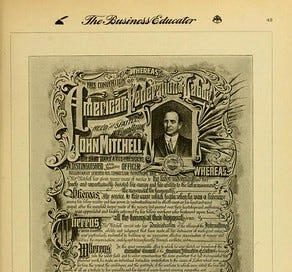#32: CIVICS 101: The Legislative Branch
Q&A #32: Who are the officers of the Senate, how are they chosen, and what are their duties? (Part 1)
Our American Government
Our American Government is a small book published by the House of Representatives for citizens and those who seek a greater understanding of the American interpretation of democracy. It follows a question-and-answer format and covers a broad range of topics dealing with the three branches of our Government, the electoral process, and the role of political parties.
The Savvy Citizen is reproducing the 169 questions-and-answers through a series of posts called Civics 101. Each post will contain the Q&A as well as some additional commentary to add historical context, fun facts, or anything we believe will add to our collective understanding of these topics.
Think of it as your adult Civics class, but without the test!
Let’s keep at it.
SECTION: The Legislative Branch: The Congress
Members, Offices, and Staff
Q&A #32: Who are the officers of the Senate, how are they chosen, and what are their duties?
By resolution, the Senate elects five officers:
the Secretary,
Sergeant at Arms,
Chaplain,
Secretary for the Majority, and
Secretary for the Minority
Secretary of the Senate.— As the Senate’s chief administrative officer, the Secretary supervises offices and services supporting the Senate’s day-to-day operations, including those of the Parliamentarian and the legislative and execute business clerks responsible for processing legislative documentation. Among the other offices supervised by the Secretary are the Senate Library, the Senate Historical Office, curatorial and conservation offices, and the offices of the reporters of debates of the Daily Digest. The Secretary officially certifies the bills and resolutions passed by the Senate, records Senators’ oaths of office, records the registration of lobbyists, and administers the Federal election records required to be filed by senatorial candidates.
[To keep this short and sweet, I’ll address the other officers in the following posts!]
My Thoughts
To clarify, a resolution is a proposal approved by either or both Houses which, except for joint resolutions signed by the President, does not have the force of law. Resolutions generally fall into one of three categories:
Simple resolutions, designed H. Res. or S. Res., deal with matters entirely within the prerogatives of the respective House.
Concurrent resolutions, designated H. Con. Res., or S. Con. Res., must be passed by both Houses, but are not presented for signature by the President. Concurrent resolutions generally are used to make or amend rules applicable to both Houses, or to express the sentiment of the two Houses.
Joint resolutions, designated H.J. Res. or S. J. Res., require the approval of both Houses, and, with one exception, the signature of the President, and have the force of law if approved. There is no real difference between a bill and a joint resolution. The latter is generally used in dealing with limited matters, such as a single appropriation for a specific purpose, or for the declaration of war. Joint resolutions are also used to propose amendments to the Constitution, but these do not require the President’s signature.
Note that a continuing resolution is a joint appropriations measure providing emergency funding for agencies whose regular appropriations bill has not been passed.
—
Back next time with Part 2 of Q&A #32 followed by Q&A #33: What are party Leaders?
Meanwhile, don’t forget that we’re organizing the post links on a single page available here.
xo,
Kelley for the Savvy Citizen Team
December 26, 2024




